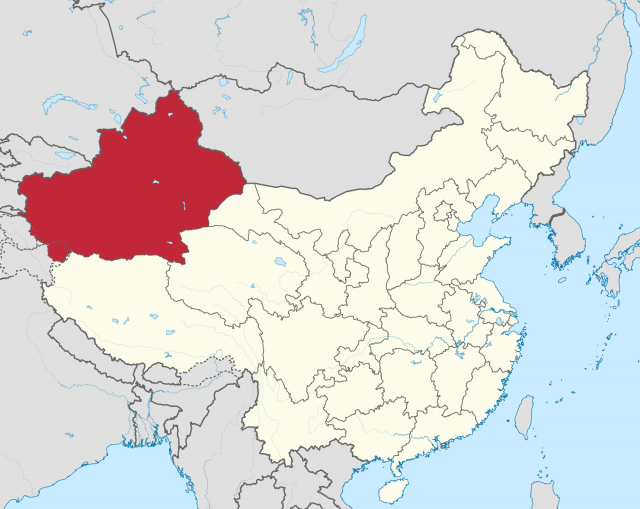Xinjiang
THE XINJIANG UYGUR Autonomous Region (eastern Turkistan) is one of the CHINA's five autonomous regions and the largest provincial division. Xinjiang has an area of 635,871 square mi (1,646,900 square km) and a population of 19,250,000, and its capital is Urumqi. Xinjiang borders Tibet, Qinghai, Gansu, MONGOLIA, KAZAKHSTAN, KYRGYZSTAN, TAJIKISTAN, AFGHANISTAN, PAKISTAN, RUSSIA, and INDIA. Natural resources include crude oil, gas, iron, copper, gold, green
jade, manganese, expanded perlite, quartz, marble, asbestos, boron, coal, iron, salt, gold, beryllium, lithium, white mica, albite, serpentines, uranium.
One of China's major pastoral areas, Xinjiang has livestock breeding. Local craftspeople produce carpets, leather, and fine cashmere. Hotan is the main jade production center of the world. Agriculture produce includes wheat, corn, cotton, silk cocoons, seedless grapes, and hami melons.

The Kunlun mountain range delimits the southwestern border of Xinjiang, at the southern end of the Pamir and Karakoram range. It also forms the north border of Tibet, eastward from KASHMIR, and delimits the southern border of the TARIM BASIN, occupied by the Takla Makan desert. This, the world's secondbiggest desert is enclosed in the north by the TIAN SHAN range, which also forms the southern border of the Dzungar Basin covered by the Dzungarian Desert, closed at the north by the ALTAI MOUNTAINS.
The glaciers of these rugged mountains form all the rivers that run across the basins and oases flanking the Tian Shan mountains. The lakes cover a total of 3,745 square mi (9,700 square km). Tourist attractions include the ancient cities of Gaochang, with the Bizaklik Thousand Budda Caves and Turpan, with grottos enriched by mural paintings. Tianchi is one of the main tourist attractions in China, known as Jade Lake.
In the past, Xinjiang was part of the SILK ROAD and became famous for trading with the Roman and Persian empires. Buddhism came to China from India through Xinjiang. In the 16th century, the economy crashed because of trading routes had changed to the oceans.
Xinjiang, a melting pot, has 47 ethnic groups. Consequently, the region's religion (ISLAM) and ethnicity (Uygur, Huis, Kazakh, and Kyrgyz) are different from the rest of China. Uygur is the spoken language, but Chinese is taught in school. China has engaged in a policy of ethnic migration, shifting Han populations to Xinjiang, so today the non-Han component of Uygurs accounts for 8.4 million of the region's roughly 19 million people. Most Uygurs are excluded from the political system administered by China's capital, BEIJING, and protest violently.
China is characterized by imbalanced regional growth. The coastal regions have more developed infrastructures and are closer to business centers. In 1998, the average gross domestic product (GDP) for coastal provinces was about 2.2 times the average GDP of interior provinces. Since 1999, the development of the interior provinces has received high priority in state policy. The Tarim oil field in Xinjiang is the secondlargest oil field on China's mainland, accounting for 30 percent of China's total reserves. It provides, through a west-to-east pipeline and railroad, oil to coastal cities and lessens China's dependence on imported oil.